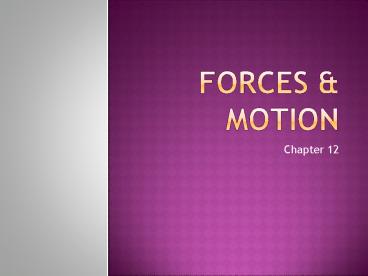Forces - PowerPoint PPT Presentation
1 / 21
Title:
Forces
Description:
Chapter 12 Force push or a pull that acts on an object Balanced forces two forces that are equal in size and opposite in direction Unbalanced forces NOT ... – PowerPoint PPT presentation
Number of Views:106
Avg rating:3.0/5.0
Title: Forces
1
Forces Motion
- Chapter 12
2
Forces
- Force push or a pull that acts on an object
- Balanced forces two forces that are equal in
size and opposite in direction - Unbalanced forces NOT equal and opposite
- Net force changes the velocity of the object
3
Friction
- Friction a force that opposes motion
4
Types of Friction
- Static Friction acts on objects that are not
moving - Sliding friction when two solid surfaces slide
over each other - Rolling friction acts on rolling objects
- Fluid friction when an object moves through
liquid or gas
5
Gravity
- Force that acts between any two masses
- Gravity pulls down, air resistance pushes up
- Terminal Velocity
- constant velocity of a falling object
- Air resistance equals force of gravity
6
Newtons First Law
- An object at rest will stay at rest, and an
object in motion will stay in motion at constant
velocity, unless acted upon by an unbalanced
force.
7
1st Law Continued
- Inertia is the tendency of an object to resist
changes in its velocity whether in motion or
motionless.
These pumpkins will not move unless acted on by
an unbalanced force.
8
1st Law Continued
- Unless acted upon by an unbalanced force, this
golf ball would sit on the tee forever.
9
1st Law Continued
- Once airborne, unless acted on by an unbalanced
force (gravity and air fluid friction), it
would never stop!
10
Newtons 1st Law and You
Dont let this be you. Wear seat belts. Because
of inertia, objects (including you) resist
changes in their motion. When the car going 80
km/hour is stopped by the brick wall, your body
keeps moving at 80 m/hour.
11
- Why then, do we observe every day objects in
motion slowing down and becoming motionless
seemingly without an outside force? - Its a force we sometimes cannot see friction.
12
Newtons Second Law
- The net force of an object is equal to the
product of its mass and acceleration, or Fma.
F ma
13
- Newtons 2nd Law proves that different masses
accelerate to the earth at the same rate, (the
rate of gravity) but land with different forces. - So why is it that different objects appear to
fall slower or faster?
14
Newtons Third Law
- For every action there is an equal and opposite
reaction - Whenever one object exerts a force on a second
object, the second object exerts an equal and
opposite force on the first object
15
Newtons third Law cont
- Example If you punch someone in the face, your
hand applies a force to that persons face and
their face applies a force to your hand (dont
try this at home!)
16
Momentum
- Momentum is the product of mass and velocity
- Abbreviated with a little
- p
- Law of Conservation of
- Momentum In a closed system, the loss of
momentum of one object equals the gain in
momentum of another momentum is conserved
17
Universal Forces
- There are four universal forces that we currently
know of. Scientists continue to study these and
are searching for a unified theory that relates
them better! - Universal forces act over a distance between
particles of matter. - The particles need not be in contact.
- Force is affected by the distance between
particles. - Electromagnetic
- Strong Nuclear
- Weak Nuclear
- Gravitational
18
Electromagnetic Force
- Associated with charged particles
- Electric and magnetic force are two different
aspects of the electromagnetic force. - Electric and magnetic force are the only forces
that both attract and repel - Objects with opposite charges attract one
another. - Objects with like charges repel one another.
19
Nuclear Forces
- Strong Nuclear Force powerful attraction acting
on neutrons and protons in the nucleus, holding
them together. Overcomes the electric force of
repulsion that acts among the protons in the
nucleus. More than 100 times stronger than the
electromagnetic force. Very short range. - Weak Nuclear Force weaker than the strong force.
Involved in certain types of radioactive
processes.
20
Gravitational Force
- Gravity is the weakest universal force, but it is
the most effective force over long distances. - Newtons law of universal gravitation states that
every object in the universe attracts every other
object. - Gravitational force is an attractive force that
acts between any two masses. - Gravitational force depends upon mass and
distance. - FGm1m2
- r2
21
- The moons inertia acts to move it away from
Earth. - Earths gravitational attraction keeps the moon
in a nearly circular orbit around Earth. - A centripetal force is a center-directed force
that continuously changes the direction of an
object to make it move in a circle.

